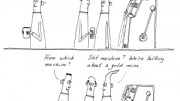Phew, was 2015 a tough year for miners! As we look back and tie a bow around the fourth year of the downturn in commodity prices and the mining sector, we see an industry in defensive mode, spending more time and energy reacting to harsh, global economic forces than charting their own paths forward.
In July, we saw the end of the Commodity Supercyle, as commodity prices represented by the Bloomberg Commodity Index returned to levels last seen in 2002 — or right back to where they were at the start of the much-beloved Supercycle that peaked in 2011. (To be fair, most other industries have limped along in recession or low-growth mode since the onset of the global recession in 2008, while the mining industry gained some respite with that freaky boom in 2010–11, fuelled by a still-voracious Chinese demand for raw commodities.)
Throughout 2015, economic forecasters returned again and again to the importance of the unexpectedly slower growth in the Chinese economy, which has translated into falling commodity demand and lower commodity prices, pretty much across the board. The depreciation of the Chinese renminbi and the Shanghai stock market crash in June took special prominence in the news.
Collapse in oil prices — Add record production to anemic demand, and in the oil sector we got oil prices crashing to 11-year lows of US$37 per barrel in December 2015, down from the long-held US$100 level last seen in mid-2014. Oil consumers reaped the benefits of an unusual market-share showdown between OPEC producers led by Saudi Arabia and U.S. shale-oil producers. Miners had mixed feelings about it all, as they enjoyed lower oil costs, as well as lower labour costs in petro-currencies such as the Canadian dollar, but still got swept up in the massive negative sentiment directed towards the oil sector.
A world awash in iron ore — The ramping up of iron ore production at the low-cost mega-mines of Western Australia controlled by BHP Billion and Rio Tinto, plus Vale’s Brazilian mines, combined with a fall-off in Chinese steelmaking, resulted in a glut of iron ore on the world stage. Iron ore prices have sunk to the US$40-per-tonne level, taking with it other steel-related products such as nickel, molybdenum and metallurgical coal. Even as high-cost iron ore mines close around the world, Goldman Sachs predicts the iron ore price will stay under US$40 per tonne for the next three years, as China’s slowdown forces the global iron ore industry into a long hibernation.
Girls have a new BFF other than diamonds — During the last commodity downturn, consumer demand for diamonds protected the diamond-mining industry from the ravages affecting the rest of the mining sector, but this wasn’t the case in 2015. According to figures from the Antwerp Diamond Centre and Bain & Co., prices for polished and rough diamonds have fallen 12% and 23% since May 2014, and 8% and 15% since the start of 2015. With the biggest diamond miners broadly keeping their production levels steady over the past year, overall revenues for 2015 may be down 15% to 20%. As a consumer product, diamonds are increasignly losing out to luxury items such as smartphones, designer clothing and vacations.
Samarco tailings disaster — In terms of areal extent of damage, the Samarco iron ore mine spill in Minas Gerais, Brazil, is one of the worst in history. The Fundao tailings dam at the mine — which is owned by super-majors BHP Billiton and Vale — collapsed on Nov. 5, killing at least 17 people and making 650 homeless. The spill of the equivalent of 20,000 Olympic swimming pools of mud waste has affected more than a dozen riverside towns and cities on its way to the Atlantic Ocean, 500 km downstream, with the cost of environmental damage estimated at US$7 billion. BHP and Vale’s share prices have fallen 30% since the disaster.
Lithium gets trendy — Who would’ve guessed the light at the end of the tunnel would be powered by lithium batteries with a heavy graphite component? The junior mining market always needs a fresh story to tell, and a good one comes in the form of a booming market in lightweight lithium batteries for leading-edge products, such as Tesla’s electric sedans and energy storage products. This past year, dozens of lithium and graphite juniors have raised money and carried out substantial work programs around the world, as companies such as Tesla line up crucial battery-component supply for a major ramp-up in battery production.




Be the first to comment on "Editorial: Top stories of 2015"